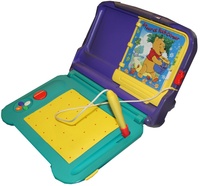Sega Pico
| Home > Browse Our Collection > Games Consoles > Sega > Sega Pico |
|
The Sega Pico, known in Japan as the Kids Computer Pico, is a video game console made by Sega and designed for children between the ages of 2 and 8. The Pico was Sega's first "educational" console, running in parallel with more traditional games consoles aimed at the mass market. Debuting in mid-1993, the Pico was supported in Japan until 2005 when its successor, the Advanced Pico Beena was released. Though relatively obscure in the eyes of many, the Pico stands as one of the most successful devices of its kind, being the first educational console to ship globally and the primary inspiration for devices from LeapFrog and VTech which emerged in the years that followed. It was the first console to use touch controls as the default control scheme (the first in general was the Sega SG-1000's optional Sega Graphic Board controller). It was also the earliest known device to use active digitizer technology. All Picos are made up of two foldable halves allowing for portability and easy storage. The bottom half rests on a flat surface and acts as the primary source of input, while the top is held at a 90-degree angle, supported by a support at the back. Also included is a handle for easy transportation, and with the exception of TV and power connectors, everything is built-in to the unit. The Pico has five, unlabled face buttons on the bottom left - one large red button (often mistaken for a d-pad), and four smaller white, green, orange, and purple buttons. Most notably, the Pico has a "touch pad" and a hard-wired "Magic Pen" for manipulating this pad (the Magic Pen also acts an extra button when pressed down). Picos also have an expansion port on the right hand side, and in early models, a DE-9 port, which is presumed to have gone unused. Picos, like most home consoles, connect to televisions. Interestingly the Pico relies on composite video for its display, as opposed to the then-standard RF technology, providing better image quality than many other systems of the era. The Pico also needs an AC adaptor, similar to those used with the Sega Mega Drive Model 2 and Sega 32X. Pico cartridges are affectionately called "storyware", with each cartridge shaped like a book with multiple "pages". Cartridges plug into the top half of the system and pages open out to fill the space, with games recognising which pages have been turned and changing the TV display accordingly. The Pico's cartridge slot "pivots", meaing cartridges can be placed in the system at an angle and locked into place when in use. The last "page" of each cartridge can also be manipulated by the Magic Pen, effectively creating two touch pads. From a technical perspective, the Sega Pico uses hardware derived from the Sega Mega Drive, lacking only a Zilog Z80 and a YM2612 for driving FM Sound. Additional hardware allows it to sense which page the user has turned to and sense the position of the pen. An additional DMA chip is present to allow streaming PCM voice samples to be played. Manufacturer: Sega Other Systems Related To Sega Pico:
This exhibit has a reference ID of CH39949. Please quote this reference ID in any communication with the Centre for Computing History. |
Click on the Image(s) For Detail
|











